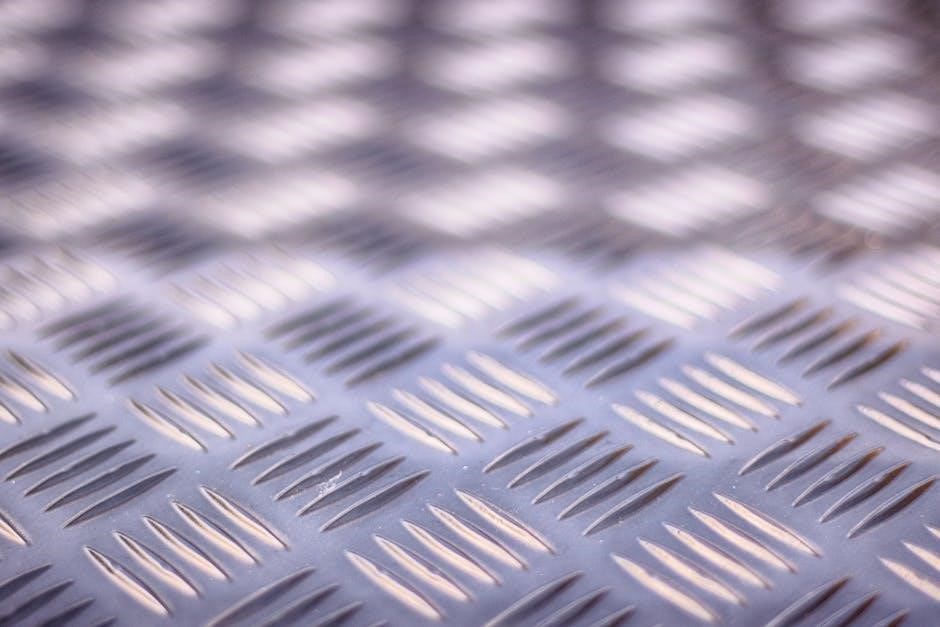Traction therapy involves applying a pulling force to relieve pain and align bones or spinal structures. It uses weights and pulleys to create controlled tension, aiding recovery and mobility.
Commonly used in orthopedics and physical therapy, traction therapy helps reduce muscle spasms and improves joint alignment, promoting healing and restoring function in injured or affected areas effectively.
1.1 Definition and Purpose of Traction
Traction is a medical technique that applies a controlled pulling force to specific parts of the body, often using weights, pulleys, or specialized devices. Its primary purpose is to relieve pressure on muscles, bones, and joints, helping to restore alignment, reduce pain, and promote healing. Commonly used in orthopedics and physical therapy, traction is particularly effective for conditions like fractures, spinal misalignments, and muscle spasms. By creating a gentle, sustained force, traction can improve mobility, reduce inflammation, and enhance the recovery process, making it a versatile and valuable treatment option for various musculoskeletal disorders and injuries.
1.2 Historical Background of Traction Therapy
Traction therapy has ancient roots, with evidence of its use dating back to early civilizations. In ancient Egypt and China, manual traction techniques were employed to treat spinal and joint disorders. The Greek physician Hippocrates (460-370 BCE) is known to have used wooden frames and pulleys to apply traction for orthopedic conditions. During the Middle Ages, traction fell out of favor but regained prominence in the 19th century with advancements in medical technology. By the 20th century, traction therapy became a standardized treatment, incorporating mechanical and electrical devices to enhance precision and effectiveness. This historical evolution underscores its enduring relevance as a therapeutic modality in modern medicine.
Types of Traction
Traction is categorized into skin, skeletal, and mechanical types, each applying force differently to relieve pain, align bones, or support recovery in various medical conditions effectively.
2.1 Skin Traction
Skin traction applies force directly to the skin using adhesive tapes or straps. It’s non-invasive and commonly used for minor injuries or post-surgical recovery, providing gentle alignment and support.
2.2 Skeletal Traction

Skeletal traction involves attaching devices like pins, wires, or screws directly to bones to apply force. This method is more invasive than skin traction and is used for severe injuries or post-surgical recovery.
It provides precise alignment and stability, especially for complex fractures or spinal conditions. Skeletal traction is commonly used in orthopedic and trauma cases, offering a reliable way to manage bone positioning and promote healing effectively.
2.3 Mechanical Traction

Mechanical traction employs specialized equipment to apply controlled forces to the body. This method is widely used in physical therapy for conditions like herniated discs and spinal stenosis.
It involves the use of motors and gears to create precise traction forces, often combined with computerized systems for accuracy. Mechanical traction is favored for its consistency and ability to target specific areas, making it effective for chronic back pain and postural alignment issues.

Medical Applications of Traction
Traction therapy is widely used to relieve pain, improve mobility, and align bones or spinal structures. It aids in treating fractures, herniated discs, and spinal deformities effectively in medical settings.

3.1 Traction in Orthopedics

In orthopedics, traction is a fundamental treatment method for managing fractures, dislocations, and musculoskeletal injuries. It involves applying controlled pulling forces to align and stabilize bones, promoting proper healing and reducing discomfort. Traction therapy is particularly effective in cases where surgical intervention is not immediately required or is contraindicated. By immobilizing the affected area and relieving muscle spasms, it facilitates the natural repair process of bones and soft tissues. Orthopedic traction is often combined with physical therapy to restore mobility and strength post-treatment, making it a versatile and essential tool in modern orthopedic care.
3.2 Traction for Spinal Conditions
Traction therapy is widely used to address various spinal conditions, such as herniated discs, spinal stenosis, and degenerative disc disease. By applying controlled pulling forces, it helps relieve pressure on the spine, reducing pain and discomfort. Skin and mechanical traction methods are commonly employed, with the latter being more intense and often used in clinical settings. Underwater traction, as studied in recent research, offers a unique approach by utilizing water’s buoyancy to reduce spinal pressure, promoting relaxation and healing. This method has shown promise in treating lumbar back pain, as highlighted in a literature review. Traction therapy is often combined with physical therapy and exercise to enhance spinal alignment and mobility, making it a valuable treatment option for patients seeking non-invasive relief from spinal issues, potentially avoiding surgical interventions.
Electric Traction Systems
Electric traction systems utilize advanced motors and control technologies for efficient power transmission in railways and industrial applications, enhancing performance and reducing energy consumption significantly.
4.1 Electric Traction Motors

Electric traction motors are key components in modern transportation systems, providing the necessary power for movement. These motors are highly efficient and reliable, designed to handle varying loads and speeds.
Synchronous electric machines with permanent magnet excitation are widely used due to their high torque density and energy efficiency. They are particularly favored in high-speed rail applications for their consistent performance.
Recent advancements include improved thermal management systems to prevent overheating and advanced control algorithms for optimal energy use. These motors play a crucial role in reducing operational costs and environmental impact in transportation.
Their durability and adaptability make them ideal for both urban and intercity rail systems, ensuring smooth and efficient traction force delivery in diverse operational conditions.
4.2 High-Speed Railways and Traction
High-speed railways rely heavily on advanced traction systems to achieve optimal performance. Electric traction motors, coupled with pantograph systems, ensure efficient power transmission and maintenance of contact with overhead lines at high speeds.
Modern high-speed rail systems use synchronous motors with permanent magnet excitation, offering high power density and energy efficiency. These systems are designed to handle the unique demands of high-speed operation, including precise speed control and minimal energy loss.
Traction systems in high-speed railways must also address challenges like wheel-rail interaction and aerodynamic drag. Advanced engineering solutions, such as regenerative braking, further enhance energy efficiency and overall system reliability.

Such innovations ensure that high-speed railways remain a benchmark for efficient and sustainable transportation, leveraging cutting-edge traction technology to meet growing mobility demands.

Case Studies and Research
Research highlights the efficacy of traction therapy in treating lumbar back pain and spinal conditions. Studies explore underwater traction and mechanical systems, offering insights into optimal treatment protocols.
5.1 Studies on Lumbar Back Pain Treatment
Research on lumbar back pain treatment highlights traction therapy as an effective method for relieving symptoms. A study by NG Badalov (2017) explores underwater traction therapy, emphasizing its benefits in reducing pain and improving mobility for patients with chronic lumbar conditions. The study suggests that controlled traction forces can alleviate muscle spasms and promote spinal alignment. Another study by DV Petrachkov (2017) investigates minimally invasive methods, such as pneumatic induction, to treat vitreomacular traction syndrome, offering insights into traction’s versatility. These findings underscore traction’s role in addressing lumbar back pain, though debates persist regarding optimal application and long-term effectiveness. Further research continues to refine traction techniques for better patient outcomes.
5.2 Underwater Traction Therapy Research
Underwater traction therapy has gained attention for its unique approach to treating lumbar back pain. A 2017 study by NG Badalov investigates the effects of underwater traction, highlighting its ability to reduce pain and improve mobility. The buoyancy of water enhances the traction force, allowing for deeper relaxation of muscles and ligaments. This method is particularly beneficial for patients with chronic conditions, as it minimizes discomfort during treatment. The study also notes that underwater traction can be combined with other therapies for enhanced results. However, further research is needed to establish standardized protocols and long-term efficacy. This innovative approach shows promise in advancing traction therapy for spinal conditions.

Future Trends in Traction Technology
Future trends in traction technology are focused on advancing materials and integration with smart systems. Research highlights the potential of lightweight, durable materials for improved efficiency. Electric traction motors, particularly synchronous machines with permanent magnets, are expected to dominate due to their high performance and energy efficiency. Innovations in control systems and real-time monitoring will enhance precision and safety in high-speed rail and medical applications. Additionally, underwater traction therapy is being explored for its therapeutic benefits, combining buoyancy with controlled force for spinal and orthopedic treatments. These advancements aim to optimize traction systems for both industrial and medical use, ensuring better outcomes and sustainability in the future.


